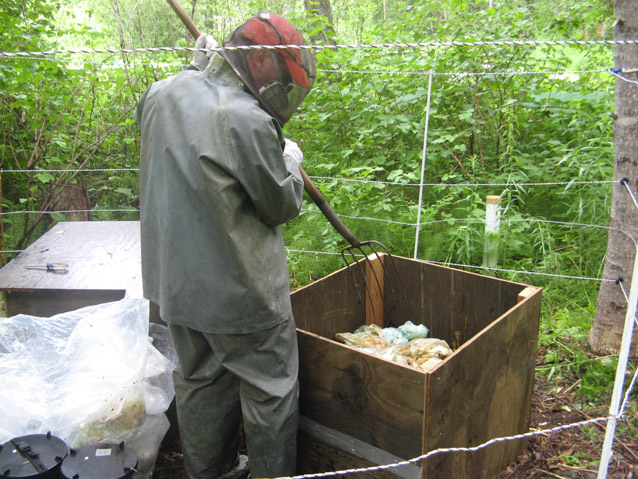
NPS Photo
Intent on using a pitchfork to break open 2-gallon (8-liter) bags of human waste, the man wore a respirator to quell the stench. What would possess anyone to place bagged human feces in wooden bins for study? This smelly venture, which took place in Talkeetna, Alaska, the town from which most climbers initiate their flights to Base Camp, tested an innovative idea of recycling the waste of mountaineers on Mount McKinley.
Each year, the ~1,200 climbers attempting to summit Mount McKinley generate about 7,500 pounds (3,400 kg) of solid human waste. To reduce health risks to climbers, and improve mountain aesthetics, Roger Robinson, a climbing ranger at Denali National Park and Preserve since 1980, worked with staff and the American Alpine Club to introduce the use of the Clean Mountain Can (CMC) to transport human waste off Mount McKinley. Since 2007, mountaineers have been required to use CMCs for solid waste above the 14,000’ Camp (4,267 m), as well as at Base Camp and the airstrip at 7,200’ (2,200 m). Lined with a compostable bag which can be easily removed, one CMC holds about 10 uses. Approximately 20 percent of the waste from CMCs is flown to Talkeetna. The remaining waste is crevassed in authorized locations.
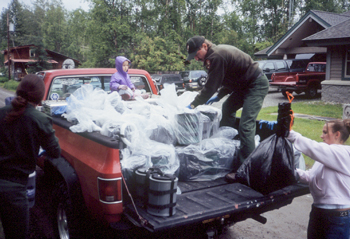
NPS Photo
Waste not—can all this CMC waste be recycled?
From Talkeetna, the CMC bagged waste is driven 70 miles (~110 km) south to Wasilla and dumped into a holding container. Once full, this container is trucked another 50 miles (80 km) south to an Anchorage wastewater treatment plant. After the CMCs are sanitized in Wasilla, they are returned to Talkeetna. Wanting to build on the success of CMCs in keeping some human waste from being crevassed in glaciers, Robinson began to think creatively about treating the CMC waste locally and promoting sustainability—to avoid the expense and fuel required to transport the waste long distances, eliminate facility processing costs, and create a sterilized, nutrient-rich product. To further the conversation about human waste, in 2010, Robinson coordinated a conference in Colorado, called Exit Strategies—Managing Human Waste in the Wild Conference. There, he collaborated with Geoff Hill, who was pursuing his Ph.D. at the University of British Columbia in the management of human waste at remote sites. Other conference participants also expressed the need for simple, inexpensive options to manage waste in many international locations that are cold, remote environments lacking roads, septic systems, electricity, or transport via helicopter sling loads. Hill presented vermicomposting (using worms to aid composting) as an alternative to waste management for these situations, and Robinson decided to put this idea to the test in Denali. In 2012, with Hill’s guidance, Robinson initiated a pilot study in Talkeetna—to test whether vermicomposting (to decompose and stabilize the organic matter), followed by the addition of a mixture of urea and ash (to sterilize any remaining pathogens), could create a safe and beneficial soil product. Expanding his thinking from Denali to the rest of the world, Robinson framed his ideas with two basic questions: (1) Can vermicomposting be successful in a cold environment using simple and low-cost materials? (2) Will the final product be safe?
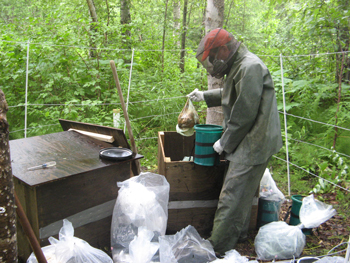
NPS Photo
Setting up control and study bins
To duplicate the conditions found in remote areas where insulation or added heat would not be an option, Robinson built two outdoor, above-ground, uninsulated wooden boxes or bins—about 1 cubic yard (0.7 m3) in size—one as a control (with only contents of the CMC) and one as a study bin (with CMC contents plus worms and minor additions).
In early July 2012, Robinson placed 30 pounds (14 kg) of “used” CMC liner bags containing human feces and toilet paper in the control bin. He used a pitchfork to break open the liner bags, but otherwise left this bin undisturbed from 2012 through 2014. To the study bin, he added 90 pounds (42 kg) of CMC bags (with waste and toilet paper) and added an equal weight of garden compost, which included a small quantity of local worms (Dendobaena octaedra). He broke open the bags to mix the contents with the compost. The compost provided the worms with a stable organic matter base for their decomposing activities. In mid-July, he added 4,000 commercially-purchased red worms (Lumbricus rubella), which are more voracious, to accelerate the vermicomposting process. Robinson also placed a temperature sensor in the center of each bin. Several pounds of food scraps, old leaves, and water were added to the study bin on two occasions (later in 2012 and once in 2013) to maintain adequate moisture and provide additional food for the worms.
A key aspect of the vermiculture pilot study was that the waste being processed had to be relatively free of urine. The CMC liner bags and toilet paper could be composted, but if the human waste contained too much urine, the salts and ammonia in it would have been lethal to the worms. CMCs may contain some urine, but not much, because when they are distributed, climbers are instructed not to use the CMC for urination, and the sheer weight of urine means most climbers comply.
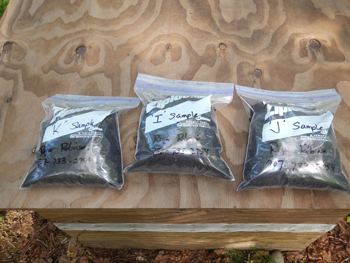
NPS Photo
More process and findings
At the very end of the first summer season (October 2012), Robinson collected four samples from the study bin and sent them to a lab to be tested for moisture, pH, nitrate, ammonia, and E. coli. The worms had reduced the bacteria levels by about 90 percent of what would be expected in raw human waste. The results also indicated the bin contained an ideal environment for vermicomposting.
The temperature sensor indicated that the compost temperature during winter 2012-2013 reached a low of -14 oF (-10 oC). The imported red worms, sensitive to freezing, did not survive, so in May 2013, Robinson added more local worms to the study bin. These worms were more adapted to the Alaskan environment and continued to produce the worm castings needed for composting.
By October 2013, the study bin contained the product of nearly two summers of vermiculture on composted feces. The worms had stabilized the waste into material resembling black and crumbly soil. Robinson sent off four more samples for analysis. The results indicated virtually nondetectable levels of fecal coliforms and E. coli (99.99% kill of pathogens). However, an additional sanitization step was necessary to be sure there was 100% kill of all harmful pathogens including viruses, protozoa, and hookworms. Hill recommended adding a combination of urea fertilizer and ash, based on the findings of Annika Nordin and colleagues in Sweden, who use urea and ash to “sanitize” human feces and produce safe fertilizers. Urea increases the concentration of ammonia, and ash increases the pH. Both high ammonia levels and a high pH are lethal to all forms of life, including the most resistant pathogens—and worms. In early May 2014, Robinson mixed the recommended proportion of urea with ash and lightly watered it into the bin.
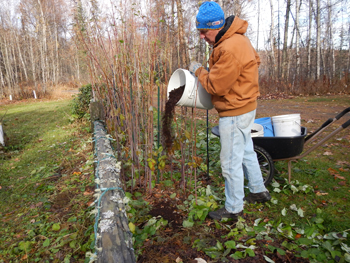
NPS Photo
A Measure of Success
In July 2014, Robinson collected three more samples from the study bin. Results confirmed that there was no trace of fecal coliforms or E. coli in the compost. As for the control bin, time alone was not sufficient for composting the CMC waste—poop still looked like poop two years later. Robinson did not confirm the obvious by testing samples from the control bin.
At the end of summer 2014, to close his pilot study, Robinson scattered the nutrient-rich, pathogenfree soils on gardens in Talkeetna. The answer to both of Robinson’s questions was a resounding yes. Yes, the process of vermiculture was successful in a northern environment using simple low-cost bins, worms, urea fertilizer and ash, and compost. And yes, the final addition of urea and ash rendered the vermiculture soil sufficiently pathogen-free to use it in public places.
What started out as reeking and gross bags of fecal waste from mountaineers—after a radical transformation by worms—ended up as a safe nutrient-rich product. Robinson is especially hopeful that the successes of this pilot study, using CMC waste from Mount McKinley, can be applied to benefit remote locations around the globe. Recycling human waste reduces the environmental impacts of accumulating wastes or the problem of transporting them, and yields a pathogen-free fertilizer that could enhance local agriculture. With simple, low-cost supplies, those working in remote locations could accomplish the same successes Robinson initiated in Talkeetna. Nothing stinky about that.
Last updated: February 3, 2025
